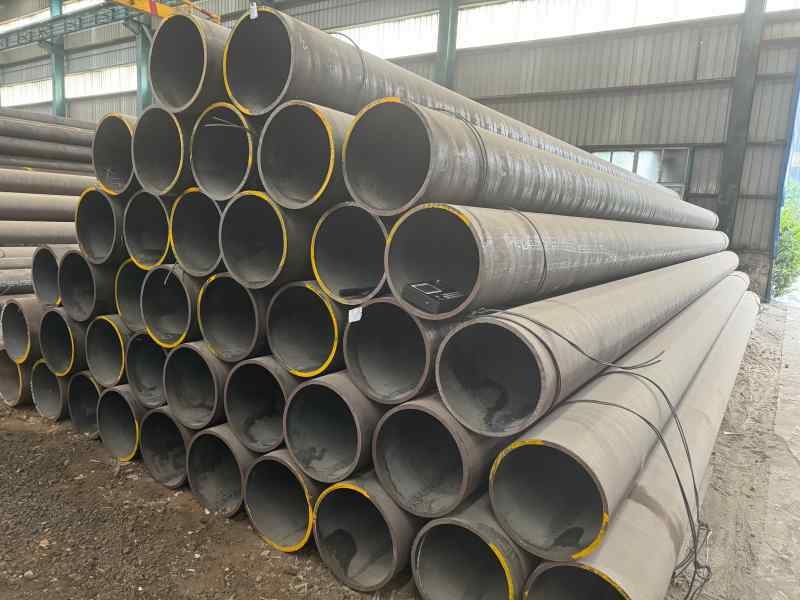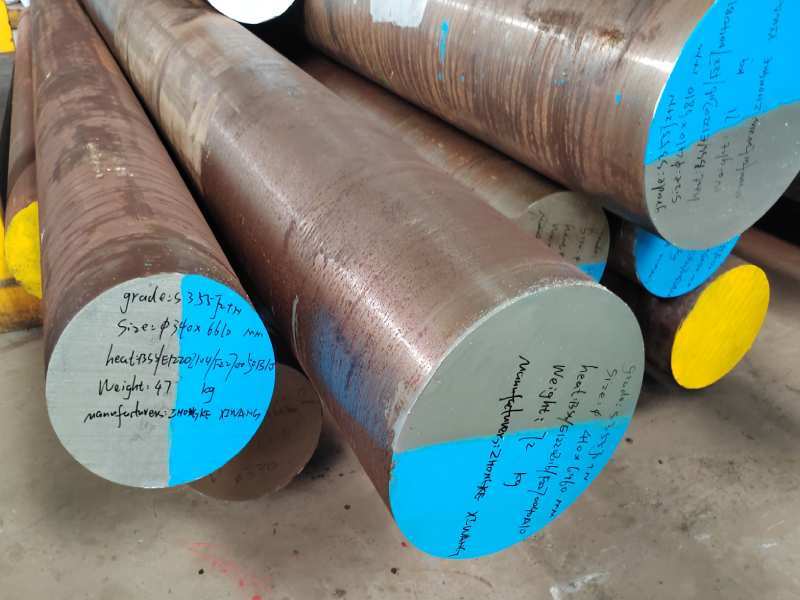10216 Steel Tube P235 P265 round sections round hollow pipe
Category:
Steel Tube
Brief description:
Unalloyed steel, alloy steel, P235 P265GH +N pressure purpose carbon steel
Key words:
Product Description
Product Description
Unalloyed steel, alloy steel, P235 P265GH +N pressure purpose carbon steel
According to the classification system of EN 10020, steel grades P195GH, P235GH, and P265GH are non-alloy quality steels, and other steel grades are alloy special steels.
The names of non-alloy steel grades are: pressure capital letter P; minimum yield strength specified at room temperature for wall thickness less than or equal to 16 mm, expressed in MPa (see Table 4): high temperature symbol GH.
Delivery status, hot rolled or cold drawn according to customer requirements
Commonly used materials in this standard include P195GH, P235GH, and P265GH, and heat treatment processes will be involved. The following introduces the different heat treatment processes required for different materials:
| Table 1 --Heat treatment conditions | |||
| Steel grade | Heat treatment a | Austenizing | |
| Steel name | Temperature ℃ | Cooling Medium | |
| P195 GH | +Nb | 880-940 | Air |
| P235 GH | +Nb | 880-940 | Air |
| P265 GH | +Nb | 880-940 | Air |
| a +N = Normalising,+NT = Normalising + Tempering,+QT = Quenching + Tempering (air or liquid), +l = Isothermal Annealing. b Normalising includes Normalising Forming. c For these steel grades it may be necessary in the case of wall thickness T above 25 mm or T/D > 0,15 to apply quenching and tempering in order to achieve the intended structure and material properties . The decision shall be left to the discretion of the manufacturer but shall be stated to the customer at the time of enquiry and order. Steel tubes treated in such a way shall be designated by the steel name supplemented by the symbol “+QT“. |
|||
The chemical elements of the above three materials are analyzed below:
| Table 2-Chemical composition (cast analysis) a, in % by mass | ||||||||||||
| Steel grade | C | SI | MN | P(Max) | S(Max) | CR | MO | NI | AL | CU | Nb | Ti |
| P195GH | ≤0.13 | ≤0.35 | ≤0.70 | 0.025 | 0.02 | ≤0.30 | ≤0.08 | ≤0.30 | ≥0.020b | ≤0.30c | ≤0.010d | 0.04d |
| P235GH | ≤0.16 | ≤0.35 | ≤1.20 | 0.025 | 0.02 | ≤0.30 | ≤0.08 | ≤0.30 | ≥0.020b | ≤0.30c | ≤0.010d | 0.04d |
| P265GH | ≤0.20 | ≤0.40 | ≤1.40 | 0.025 | 0.02 | ≤0.30 | ≤0.08 | ≤0.30 | ≥0.020b | ≤0.30c | ≤0.010d | 0.04d |
| a Elements not included in this Table shall not be intentionally added to the steel without the agreement of the purchaser, except for elements which may be added for finishing the cast. All appropriate measures shall be taken to prevent the addition of undesirable elements from scrap or other materials used in the steel making process. b This requirement is not applicable provided the steel contains a sufficient amount of other nitrogen binding elements which shall be reported. When using titanium, the producer shall verify that (Al+Ti/2)≥0,020% c Option 2: In order to facilitate subsequent forming operations, an agreed maximum copper content lower than indicated and an agreed specified maximum tin content shall apply d The content of these elements need not to be reported unless intentionally added to the cast. e For wall thickness ≥30 mm the carbon content may be increased by 0,02 % for cast and product analysis. f The upper carbon value of 0,23 % shall not be exceeded for product analysis. |
||||||||||||
The mechanical properties of the above three materials are analyzed below:
| Table 4--Mechanical properties | ||||||||||||
| Steel grade | Tensile properties at room temperature | Impact properties ab | ||||||||||
| Steel name | Upper yield strength or proof strength Reh or Rp0.2 for Wall Thickness T min | Tensile Strength Rm | Elongation A min % a | Minimum average absorbed energy KV J at a temperature of ℃ | ||||||||
| T ≤16 | 16<T≤40 | 40<T≤60 | 60<T≤100 | I | T | I | T | |||||
| MPa* | MPa* | MPa* | MPa* | MPa* | 20 | 0 | -10 | 20 | 0 | |||
| P195GH | 195 | - | - | - | 320-440 | 27 | 25 | - | 40C | 28d | - | 27C |
| P235GH | 235 | 225 | 215 | - | 360-500 | 25 | 23 | - | 40C | 28d | - | 27C |
| P265GH | 265 | 255 | 245 | - | 410-570 | 23 | 21 | - | 40C | 28d | - | 27C |
| aI = longitudinal t = transverse bTo be verified when options 4 and/or 5 are/is specified, unless footnote f) applies. c Option 4: Impact energy shall be verified. d Option 5: Longitudinal impact energy shall be verified. e For wall thickness 60 mm<T≤80 mm. f lmpact test mandatory for wall thicknessT≥16 mm. MPa =1 N/mm² |
||||||||||||
P195 GH
Corresponding standard NF EN 10216-2-2007
Pressurized seamless steel tubes for high temperatures
Classification: Carbon steel
Part I: Overview of P195GH
P195GH is a low alloy steel commonly used to manufacture high temperature and high pressure vessels and pipelines. Its chemical composition includes carbon (C), silicon (Si), manganese (Mn), phosphorus (P) and sulfur (S). P195GH has high strength, but also good toughness and plasticity, which makes it have a wide range of applications.
Part II: Characteristics and advantages of P195GH
1. High temperature resistance: P195GH has excellent high temperature resistance and can withstand working temperatures up to 150 degrees Celsius. This makes it an ideal choice for manufacturing petrochemical, power and nuclear energy equipment.
2. Good machinability: P195GH has good machinability and can be processed into products of various shapes and sizes through processes such as hot rolling, cold drawing, forging and welding.
3. Excellent corrosion resistance: P195GH improves its corrosion resistance by adding appropriate alloy elements, can resist the erosion of many corrosive media, and improves the service life of the material.
4. Reliable mechanical properties: P195GH has good mechanical properties, moderate strength and toughness, and can meet the requirements of various engineering applications.
Part III: Application fields of P195GH
1. Petrochemical industry: P195GH is often used to manufacture high-pressure vessels, heat exchangers, pipelines and other equipment, and plays an important role in the process of petroleum refining and chemical production.
2. Power industry: P195GH can be used to manufacture parts for high-temperature and high-pressure boilers and piping systems to ensure the safe and stable operation of power equipment.
3. Nuclear energy industry: P195GH can be used to manufacture reactor vessels and pipelines for nuclear power plants, with excellent high-temperature and high-pressure performance.
4. Mechanical processing: P195GH can manufacture various mechanical parts such as bolts, bearings, gears, etc., and is widely used in the field of mechanical manufacturing.
P235GH
P235GH refers to non-alloy and alloy steels with specific high-temperature properties. It has good plasticity, toughness, cold bending performance and welding performance. It is a German high-temperature structural steel. P235GH, EN10216-2 seamless steel pipe for pressure corresponds to national standards 20G, 20MnG (GB 5310-2008 seamless steel pipe for high-pressure boilers)
P235GH, EN10216-2 seamless steel pipe for pressure is suitable for manufacturing pressure vessels and equipment components. Compared with ordinary steel, P235GH alloy steel has higher strength and toughness, cold bending performance and welding performance, chemical properties, biocompatibility, physical properties and process performance.
Basic characteristics of P235GH steel plate
P235GH steel plate has excellent mechanical properties and corrosion resistance, and can maintain a stable working state under various extreme conditions. Its characteristics mainly include:
1. Plasticity and toughness: P235GH steel plate has good plasticity and toughness, and can be deformed without breaking when subjected to external force, which enables it to adapt to various complex shapes and structural designs during the manufacturing process and meet different engineering needs.
2. Cold bending performance: P235GH steel plate has good cold bending performance, which can be easily bent during the manufacturing process to meet the design requirements of various complex shapes and structures.
3. Welding performance: P235GH steel plate has good welding performance, which can ensure the quality and strength of the weld during the welding process, thereby improving the overall performance of the engineering structure.
Application field of P235GH steel plate
P235GH steel plate is widely used in high-temperature industrial fields such as petroleum, chemical industry, electric power, metallurgy, as well as petrochemical industry, power station boilers, nuclear industry, as well as shipbuilding, construction, food processing and other fields. It can withstand extreme conditions such as high pressure, high temperature, and strong corrosion to ensure the safety and reliability of engineering structures.








 +86 866358882101
+86 866358882101

 olivia@sdtuoda.com
olivia@sdtuoda.com  +86 13969540220
+86 13969540220


